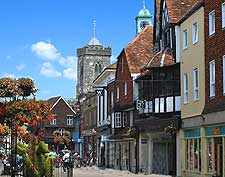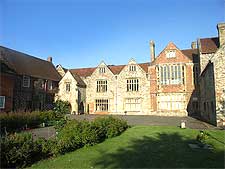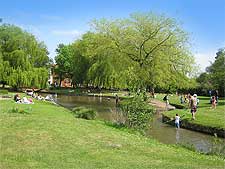Salisbury History Facts and Timeline
(Salisbury, Wiltshire, England)

The city of Salisbury is steeped in history. Its origins are thought to date to prehistoric times, over 5,000 years ago. The earliest settlement was a little way from the city's present-day site, situated on Salisbury Hill. Under the Romans, it became known as Soverodonium.
By the 11th century, a small village had grown up here. With the arrival of the Normans, it acquired a new name, Serum. From 1075, it had its own small cathedral and bishop.
A New Cathedral City
In the 12th century, Bishop Herbert Poore decided to move the settlement to land that was south of Salisbury Hill. He gave many reasons for the upheaval, including the inhospitable landscape, disputes between the church and castle, and even problems with the water supply.
The history books show that Bishop Poore began to create a new town here, complete with a grid street pattern and land for lease. The old town that he had abandoned remained inhabited for a while and became known as Old Sarum. Poore died in 1217 and it was left to his brother to carry on with his grand plan. In 1220, work was started on Salisbury Cathedral and this iconic structure took over 30 years to complete. In 1227, a charter to hold a market and an annual fair was granted. The city's new location had a favourable impact on life here. Now, it could benefit from passing trade, with travellers stopping off on their journeys from
Southampton,
London and
Exeter. It also gained in prosperity because of its vibrant wool trade.
In 1334, the cathedral acquired a new spire and this remains the tallest medieval spire in England today. The city was also home to two religious orders, the Dominicans and the Franciscans, as well as a Hospital of the Holy Trinity.

From the 17th Century to Victorian Times
Throughout the 17th and 18th centuries, the cloth trade remained Salisbury's most important industry. In fact, from the 1740s, new types of cloth were introduced here, including 'marble cloth' and 'cassimere', along with old staples such as flannels, serge, cottons and the exotically named 'fancy cloths'. In 1786, a Salisbury man was appointed as draper to the king. Other local industries in the city included cutlery and leather making. Together, they helped to maintain the city's prosperity, even when times were hard.
By the 1850s, however, it was clear that the city's industries were never going to be more than small-scale activities. Its importance was growing more as a centre for shopping, where people could visit from local towns and villages to purchase provisions. At this time, Salisbury also became a place that was popular with visitors. One of these visitors was the artist John Constable who, in 1825, painted his famous view of Salisbury Cathedral from the Bishops' Grounds. In fact, many improvements were made to make life easier for those wanting to travel here. In 1857, a direct railway line from London to Salisbury was opened, with services to
Bristol, Yeovil and Exeter following in quick succession.

Local History in the 20th Century
In modern times, Salisbury has become known for its military links. In 1901, the 2nd Army Corps set up a headquarters here, followed eight years later by Southern Command. Service men came to live in the city, creating demand for everything from military tailors to extra housing. Such links continue to this day with military use of the nearby Salisbury Plain. During World War Two, two engineering works were set up in the city, for strategic reasons. These were the Vickers Armstrong aircraft factory and the Wellworth piston factory.
Throughout the 20th century, work has been ongoing to preserve the city's rich heritage. In 1991, a £20 million programme was begun to make repairs to the cathedral spire, tower and west front, and this is still ongoing. Today, Salisbury Cathedral, which is home to one of the four remaining copies of the Magna Carta, attracts in excess of 250,000 visitors every year.
 The city of Salisbury is steeped in history. Its origins are thought to date to prehistoric times, over 5,000 years ago. The earliest settlement was a little way from the city's present-day site, situated on Salisbury Hill. Under the Romans, it became known as Soverodonium.
The city of Salisbury is steeped in history. Its origins are thought to date to prehistoric times, over 5,000 years ago. The earliest settlement was a little way from the city's present-day site, situated on Salisbury Hill. Under the Romans, it became known as Soverodonium.
